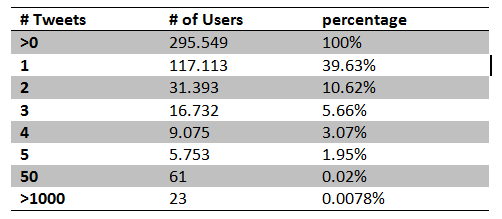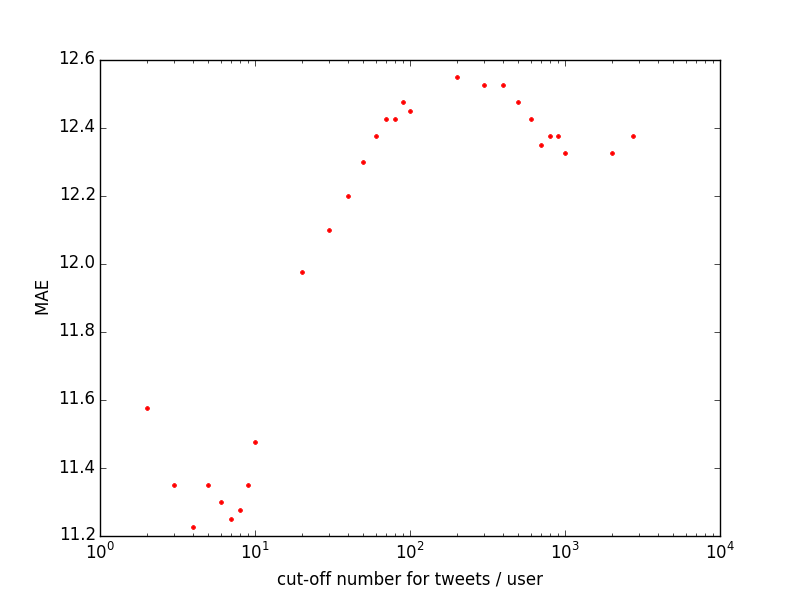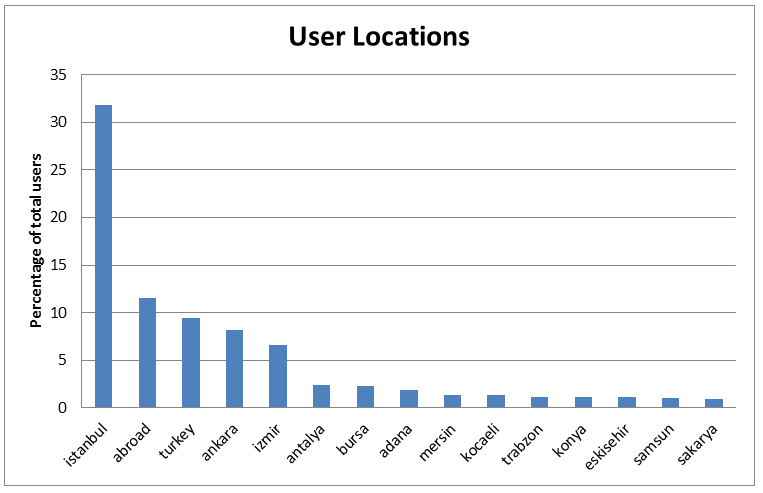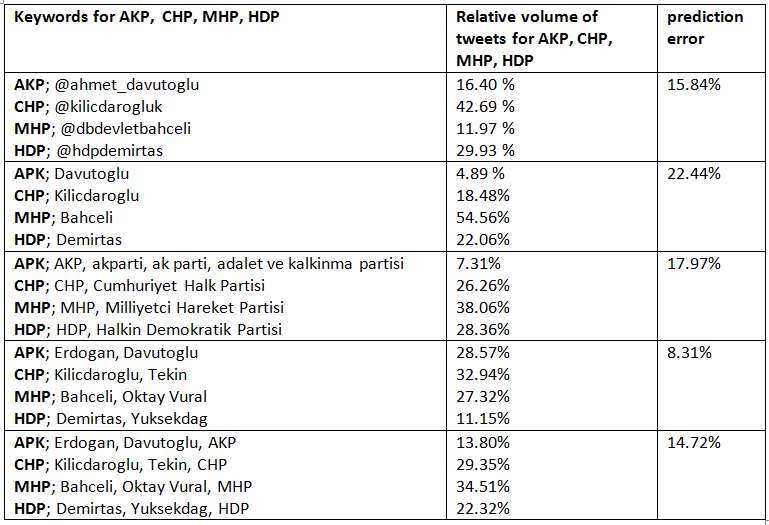Short summary:
According to Analysis of Twitter data, the upcoming elections of 1 November will result in a victory for AKP.
AKP: 47.13% CHP: 22.35% MHP: 18.84% HDP: 11.68% I will keep updating these numbers as more Twitter data is collected.
Not so short Summary:
Since the demographics of the Twitter users and the electorate of each country is unique in its own way, the boundary conditions, tuning factors and method of prediction that are fit for Turkey’ s electorate have to be determined. I have done this with data from the last election in Turkey and based on this test set, I will make a prediction about the upcoming election on 1 November. In this blog, I will explain the research done so far.
Around 936.000 Twitter messages were collected between the period of 01 may and 06 June 2015 based on a list of keywords for each party. The initial estimation deduced from the sheer volume of these Tweet messages had a prediction error (mean absolute error) of 12.4% between the predicted result and the actual election result on 7 June. After this the Tweets were Analyzed for Sentiment (by using four different subjectivity lexicons) and classified as either positive, negative or neutral. Estimations made from the Tweets which were classified as positive (and positive – negative) did not improve the performance of the estimation.
Removing Twitter messages written by users with a suspiciously large amount of Tweets did not improve the performance of the estimation. This is probably because these users only constitute a small part of all users (only 23 of the 295.549 users have written more than 1000 messages) and the absence or presence of their Tweets does not have any significant impact.
By scraping the profile pages of the users, the location could be deduced of 66.836 users (32.4%). Removing Twitter messages from every user whose location is not known to be in Turkey actually reduced the performance of the estimation (increased the MAE from 12.4% to 15.75%). The reason for this could be that the Twitter messages were already collected in such a way that they are most likely from prospective voters (by setting the language to Turkish). Removing Twitter messages from users whose location is not known or is not in Turkey (around 70% of all users) therefore just reduces the amount of significant Tweets. Since the error in estimation cancels out relative to the quantity of collected Tweets, throwing away 70% of the collected tweets is not in our best interest.
Analyzing the dates of the collected Tweets has shown that the best result is obtained when you only take the Twitter messages in the last week before the election into consideration. Reducing the time window of the Tweets to the last week, reduces the prediction error from 12.4% down to 6.8%.
However, the biggest improvement in performance was achieved by including more names of the participating politicians as keywords when collecting Twitter messages. If all of the names of the ~550 participating politicians per party are included in the data collection phase, the volume based estimation of the prediction has a prediction error of 1.175%.
Using the same method which has led to me being able to ‘predict’ the outcome of the elections in June with an accuracy of 1.175%, I am predicting the outcome of the upcoming elections on 1 November.
Research done so far:
I was also going to write about the research done so far about predicting elections from Twitter data. But I am afraid this blog will become too long. There already is a very good article about that written by Daniel Gayo-Avello. I recommend you to read this article to gain a better understanding of the research done so far and the different methodologies and terminologies used.
Introduction:
I have collected Turkish twitter messages from the period of 01 May 2015 until Election Day (7 June 2015). Since I am only interested in the opinion of prospective voters there is no point in collecting tweets from written in any language other than Turkish or an area other than Turkey. Unfortunately Twitter messages cannot be selected on location, but it is possible to collect Twitter messages based on language. Keywords were chosen such that the collected tweets will cover as much politics as possible. That is, the name of the party, its abbreviation(s), the most popular two politicians, their twitter account(s), common nicknames and misspellings of these politicians were chosen as keywords, for each of the four main parties.
The collected tweets were stored in a MongoDB database together with information about which party it is collected for, which keyword it is found with, the date and time of the tweet, the tweet-id and the Twitter user. This has resulted in 936.2365 unique tweets collected.
It is clear that the predictions based on the volume of tweets (prediction error: 12.4%) or the number of Twitter users (prediction error: 10.84%) does not come close to the actual election result.
This can be due to several reasons;
- The subjectivity of each tweet is not taken into account and once it is done (Sentiment Analysis), it will reduce the prediction error.
- There are Twitter users polluting the data. Changing the boundary conditions of the dataset of users, i.e. ‘denoising’ it by removing users who have a suspiciously large amount of tweets could reduce the prediction error.
- The period of collection is not chosen optimally. Changing the period over which the tweets have been collected, either reducing it or increasing it could reduce the prediction error. For example, maybe some of the parties will increase ‘propaganda’ Tweets the week before the election and not taking these days into account could improve the results.
- The keywords are chosen poorly and a different (combination of) a subset of the keywords will lead to a better result.
- The demographics of Twitter users in Turkey are essentially different from the demographics of the general population. Taking such information into account, the tweets could be weighted to see whether this reduces the prediction error.
In the next few paragraphs I will try to find the conditions under which we can get the best performance on the estimation by addressing these issues (except for the last one).
Does Sentiment Analysis of the tweets reduce the prediction error?
Sentiment Analysis was done on the collected tweets. This was done with four different lexicons; MPQA’s Subjectivity Lexicon, Loughran and McDonald’s Master Dictionary, Bing Liu’s opinion lexicon and SentiTurkNet. The first three are originally in English and were translated to Turkish with Bing Translate. In addition to these four lexicons, each lexicon was updated with Hogenboom’s Emoticon Sentiment lexicon to take emoticons into account.
Below the results of the Sentiment Analysis is can be seen. For each dictionary the number of tweets which were scored positive and the number of tweets which were scored negative are given together with its relative value (percentage of total positive scored Tweets). At first sight the differences seem large; with McDonald’s dictionary 736.159 tweets are scored positive while with SentiTurkNet’s dictionary only 21.247 tweets are scored positive. But this difference can partly be accounted for with the size of the dictionary (McDonald’s dictionary contains 85.131 words, BingLiu’s contains 6.789 words, MPQA’s contains 4.474 words and SentiTurkNet contains 1.498 words).
In the table above, we can see that even though there is a large difference in the absolute amount of Tweets scored positive/negative, the relative percentage of each party in this total amount of Tweets did not change much. And using a sentiment lexicon to analyse the tweets for subjectivity did not really decrease the prediction error; (12.4% for no sentiment analysis, 12.75% for MPQA, 12.57% for McDonald, 12.23% for BingLiu and 12.49% for STN)
Analyzing the users:
Remove users with a suspiciously large amount of tweets:
Now let’s have a look at the users to see if we can get better results by ‘denoising’ the dataset of users. It might be a good idea to remove users who have written an excessive amount of tweets (spammers / bots), because they do not represent the general population and probably introduce a bias in the data. After analysing the set of users we can see that largest amount of users have only written a few tweets. 117.113 users for example have only written one Tweet and another 31.393 users have only written two Tweets. As the number of Tweets goes up, the number of users who have written this many Tweets drops exponentially (see the table and figure below).
I think it is safe to say that Twitter users with less than 50 tweets (which constitute >99% of all users) can be counted among the general population. Twitter users with more than 50, 100 or 1000 tweets are either political fanatics, news agencies or Twitter bots polluting the data. How does the performance of the prediction change if we remove these users and their tweets from the dataset?
In the figures above you can see the calculated prediction error (y-axis) when users with more than a certain number of tweets (x-axis, log-scale) have been removed from the data set. As you can see the MAE does drop from 12.4% to around 11.2 % when every Twitter user with more than 8 tweets has been removed from the dataset. This is some improvement of the performance of the estimation, but not satisfying enough.
Remove the Users which are not known to be living in Turkey:
Although it is my suspicion that a high percentage of the users are already from Turkey (since I only collected Tweets written in Turkish), I do not exactly know which percentage are from Turkey and which part of Turkey they are living. It is possible however to determine the location of the users by scraping it from their Twitter profile. I did this for the 206.537 distinct users who have written the Tweets. It was possible to determine the location of 66.836 users (32.4%). From these 66.836 users, 11.57% appear to be from outside of Turkey. Most of these are however Turkish people living in various European countries; Germany, France, Netherlands, Austria etc. (And Turkish people living outside of Turkey can also vote in their country of residence).
How does the performance of the prediction change if we only include Tweets from users which are known to be living in Turkey?
Unfortunately this increases the prediction error of the estimation from 12.4% up to 15.75%. One reason for this could be that the dataset is already optimized to contain the maximum amount of Tweets from prospective voters (by setting the language to Turkish during collection). Removing all Users of which the location is not known or not in Turkey only means that ~70% of the collected Twitter messages will be thrown away. Since the error in estimation cancels out relative to the quantity of collected tweets, throwing away 70% of the collected tweets is not in our best interest.
Does changing the date-range improve the performance?
As mentioned before I had collected Tweets from the period of 01-05-15 to 06-06-15. So see whether or not the performance of the estimation improves with a different period, I can either remove any Tweet message written before a certain date or after a certain date. For example, removing any Tweet written before 05 May would probably not affect the outcome very much. But removing any Tweet written after 30 May could have a significant impact. The question I want to answer here is; do the Tweets written in the last week before Election Day have a positive or a negative impact on the performance of the estimation. And hence, does removing them decrease or increase the prediction error.
In the figure below you can see the calculated prediction error (MAE) plotted on the y-axis for two different scenarios; in the graph indicated with ‘lower cut off’ every Tweet written before the date indicated on the x-axis is removed from the dataset and the corresponding prediction error is calculated. In the graph indicated with ‘higher cut off’ this is done for every Tweet written after the dates on the x-axis.
According to this graph we get the lowest prediction error (6.8%) and hence the best performance if we cut off every Tweet written before 30 May. This means that the Tweet messages collected in the last week before the election are most representative of the voting behaviour of the Electorate.
Do a different set of keywords lead to a better result?
The research done so far was done on all Tweet messages collected with the set of keywords indicated at the beginning of the blog. Since I have saved the collected Tweets in the database together the keyword it was collected with, I can select specific subsets of keywords for each party and calculate the volume of Tweets belonging to these keywords. For example, I could select only the prime politicians, or only the party names, or only the twitter accounts of the prime politicians etc.
I have done this for a different subset of keywords, calculated the relative volume of Tweets belonging to AKP, CHP, MHP and HDP and calculated the corresponding prediction error.
It seems that a different subset of the chosen keywords does influence the performance significantly. Collecting tweets based on the Twitter address of the most important politicians, or based on the party name does not lead to a good performance. However, choosing the keywords such that it only consists of the names of the two most important politicians of the four parties, the prediction error drops from 12.4% to 8.31%. I guess what you are all wondering now is, what would happen to the performance when I take into consideration tweets with the names of the three / four / five most important politicians instead of the two most important ones. 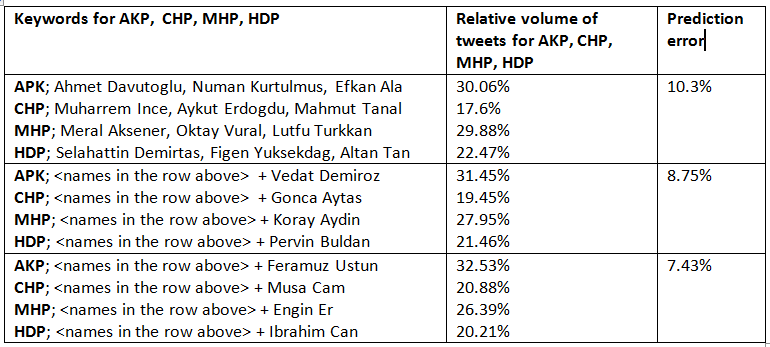
As you can see, including more politician names significantly reduces the prediction error. Then, the next question to ask is how far we can take this. So here is a crazy idea; what would happen if I scrape Twitter for Tweets including the names of all the participating politicians of all major parties in all 81 provinces? For AKP this looks something like this. This means scraping around 550 different names for each of the main party. So I have scraped these names for the period of 01 May to 06 June resulting in 893.641 unique Tweets, and for the period of 01 April to 06 June resulting in 1.470.958 unique Tweets. These Tweets are stored in the same way except for an additional field indicating the state each politician is participating in.
As you can see, the most accurate prediction is obtained by collecting as many Tweets as possible about as many politicians participating in the election as possible. Analysis on 0.8 million Tweers written in the period of 01 May to 06 June leads to a prediction with an accuracy of 2.14%. And an analysis on 1.3 million Tweets written in the period of 01 April to 06 June leads an accuracy of 1.175 %.
So, What is my prediction?
Since the only thing that matters for an accurate result is the number of Tweets and the number of politicians, I have done similar scraping of Twitter messages containing the names of all the politicians participating in the election of 1 November. This has resulted in the following prediction:
As you can see AKP and MHP will gain some votes while CHP and HDP lose some votes. Compared to traditional Election polls I am predicting a higher percentage for AKP. This makes me a little bit nervous, but if I am wrong, I can always blame it on the dataset being too small (241.283 instead of 1.346.901)
In any case, I will keep collecting Twitter data and posting the updated predictions either on this blog or on my twitter account.




